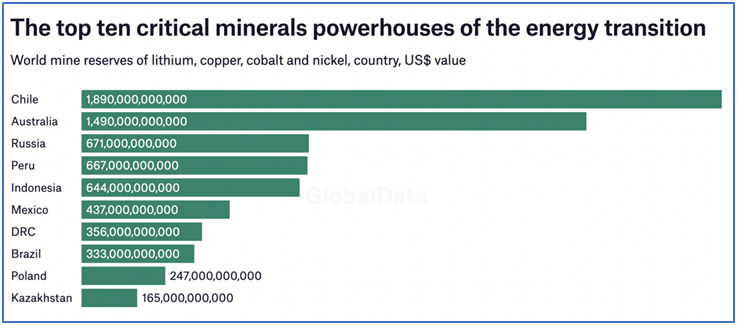Why in the News?
The Ministry of Mines launched the fourth tranche of critical minerals auction, offering a total of 21 blocks across 14 states.
What’s in Today’s Article?
- About Critical Minerals (Meaning, Characteristics, Examples, Reserves, etc.)
- News Summary
What are Critical Minerals?
- Critical minerals are raw materials essential for economic and national security, often used in high-tech industries and renewable energy technologies.
- They are typically rare, difficult to mine and substitute, and often vulnerable to supply chain disruptions due to limited global production and geopolitical factors.
- The growing demand for these minerals, driven by technological advancements and the global transition to green energy, underscores their critical importance.
- Securing a stable supply of critical minerals is thus a strategic priority for many countries to ensure economic stability and technological progress.
Characteristics of Critical Minerals:
- Economic Importance: Critical minerals are indispensable for the production of high-tech devices, electric vehicles (EVs), energy storage systems, and other key industries.
- Supply Chain Vulnerability: The supply of these minerals is often concentrated in a few countries, making them susceptible to geopolitical tensions, trade disputes, and other disruptions.
- Limited Substitutability: These minerals typically have few or no viable substitutes, which means that any disruption in their supply can have significant economic and technological impacts.
Examples of Critical Minerals:
- Lithium:
- Used in lithium-ion batteries for EVs, consumer electronics, and energy storage systems.
- According to the US Geological Survey (USGS), Australia and Chile boast the largest reserves of lithium available in mines around the world today.
- Cobalt:
- Essential for battery production, aerospace components, and other high-strength alloys.
- The Democratic Republic of Congo (DRC) is by far the largest global supplier of cobalt, possessing almost half of all cobalt reserves in global mines.
- Graphite:
- Key for batteries, fuel cells, and high-temperature applications.
- In 2023, China had the world's largest reserves of natural graphite, at approximately 78 million metric tons.
- Nickel:
- Important for stainless steel production and battery manufacturing.
- Australia and Indonesia boast the world’s largest reserves of nickel in global mines today.
- Rare Earth Elements (REEs):
- Vital for manufacturing electronics, magnets, and military applications.
- According to estimates, the total worldwide reserves of rare earths amount to approximately 110 million metric tons.
- Most of these reserves are located within China, estimated at some 44 million metric tons.
- After China, the major rare earth countries based on reserve volume are Vietnam, Russia, and Brazil.
Critical Minerals Reserves in the World & India:

- India does not have reserves of nickel, cobalt, molybdenum, rare earth elements, neodymium and indium, and the country’s requirement of copper and silver are higher than its current reserves.
India’s Critical Minerals Policy:
- India is bolstering its position in the global supply chain of critical minerals like lithium and cobalt through domestic exploration and international partnerships. The Ministry of Mines, in collaboration with the joint venture Khanij Bidesh India Ltd. (KABIL), is acquiring critical mineral assets in Australia, Argentina, and Chile to ensure a steady supply.
- India has joined the U.S.-led Mineral Security Partnership to enhance cooperation and investment in critical mineral supply chains.
- The MMDR Amendment Act, 2023, empowers the Central Government to auction mining leases and licenses for 24 critical minerals, promoting self-sufficiency and advancing sectors like high-tech electronics, telecommunications, and renewable energy.
- The first tranche of e-auction for 20 blocks of critical minerals, including lithium and rare earth elements, was launched on November 29, 2023. This initiative aims to reduce import dependency, attract mining sector investments, and support India’s goal of becoming self-reliant (Atma Nirbhar Bharat).
- Additionally, a new Exploration Licence has been introduced for 29 critical and deep-seated minerals, encouraging expertise and advanced technologies in mineral discovery and mining. This effort is expected to enhance domestic production, secure supply chains, and contribute to India's economic growth and technological advancement.
Government Offers Ten New Critical Mineral Blocks:
- The Ministry of Mines launched the fourth tranche of critical minerals auction, offering 21 blocks across 14 states.
- To incentivize exploration, the ministry announced a scheme to reimburse up to Rs 20 crore in exploration expenses for license holders.
- The fourth tranche brings the total number of critical mineral blocks offered to 48.
- The auction history has seen mixed results: out of 48 blocks, 24 have been annulled due to low bidder interest.
- The ministry remains optimistic about successful re-auctions, with efforts to intensify investor engagement.
- The newly announced exploration reimbursement scheme aims to boost investor interest.
- License holders can claim up to Rs 20 crore for exploration activities and may receive additional reimbursements if they hand over a block for mining lease within three years.
- This incentive addresses concerns about the need to re-auction blocks for mining after exploration.









